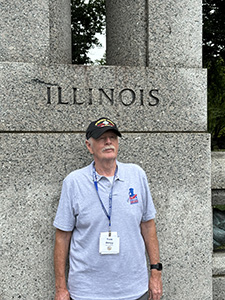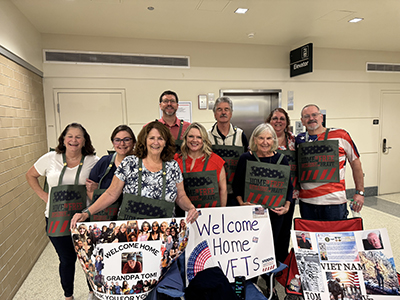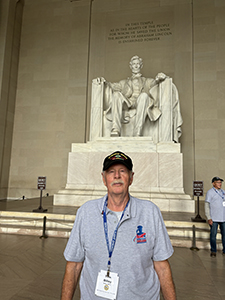Army Vietnam War Flight date: 09/25/24
By Lauren Jones, Honor Flight Chicago Veteran Interview Volunteer
At just 18, Thomas “Tom” Dilley walked into the draft board in Harvey, Illinois, determined to accelerate his enlistment for the Vietnam War. With no clear plans beyond working part-time installing air conditioners for Sears, he felt his path was already set. “All of my friends in the neighborhood were getting drafted,” Tom recalls, “so, I thought I might as well push my draft up.” His decision reflected the urgency of the times, as young men in his community were being called to serve.
Tom’s brother Bob had already been drafted and was serving in the 1st Cavalry Division in Vietnam. They wrote letters back and forth, and, in a heartfelt gesture, Bob even offered to extend his tour so Tom wouldn’t have to go. “But I couldn’t live with myself if something happened,” he says. “So, he came home after his year, and I went for mine. My poor Mom,” Tom adds. “I don’t think she slept for two years.”
In March 1967, Tom’s journey to the Army began when his dad drove him to the train station for his trip to Fort Knox. Basic training had barely started when an unexpected incident sidelined him. While finishing a night fire exercise, Tom stumbled into a hole, injuring his leg and contracting blood poisoning from a scratch on his hand, landing him in the hospital for a week. After basic training, Tom headed to Fort Polk, also known as Tigerland, for advanced infantry training. “Fort Polk was a hardcore training camp,” he recalls. “Tigerland was a pretty tough place. It helped me get ready, but I still didn’t know what to expect.”
Tom was deployed to Vietnam in September 1967, assigned to the 4th Infantry Charlie Company 1/35th Infantry Division. Shortly after arrival, he took on the role of Radio Telephone Operator (RTO) for the unit. “I reported to Lieutenant Matusek,” Tom recalls. “We were out in the field almost all the time. Basically, my job was to carry the radio and handle any incoming calls. I would hook them up with the Lieutenant, or if I had to get a hold of anybody, I knew the verbiage to use.” He laughs, remembering, “That radio was a heavy son of a gun!”
Tom served as RTO for around five months when he unfortunately caught Hepatitis A. It was right around the Tet Offensive, and he was shipped to Japan for about a month to recuperate. “We never figured out where we got it. But lots of us did. I was really sick, and so were they.”





One month. Two Purple Hearts.
In late March or early April 1968, Tom’s unit was stationed at LZ Mile High, also known as Firebase Mile High, when disaster struck—a massive explosion blew up an ammunition dump. Amid the chaos, Tom was hit by a shard of shrapnel in his hand. Despite the injury, he received quick field treatment and remained on the firebase. At the time, he had no way of knowing that this incident was a precursor to something far more harrowing around the corner.
Just a few weeks later, on April 15th, Tom’s unit was ambushed, and he was hit by a mortar round. He explains, “I caught shrapnel in all my fingers and left arm, and it shattered my knuckle. One of my best friends, a guy from California named Robert Fritsche Jr., we called him Fitch, helped me get some cover after I got wounded. I was able to get behind a log and get my rifle set up.”
But unfortunately, they had a clear shot of Fitch, and he was killed. “It was a damn shame,” Tom emphasizes. “That was not a good day.”
After basic surgery on his arm and to save his fingers, Tom had another surgery where a knuckle was removed, and fingers fused together so he could at least close his hand. By June, he was back in the field, this time serving as a team leader instead of an RTO—forever carrying the memory of that tragic day with him, both mentally and physically.
Tom explains, “I can’t really overuse my left arm, so I have to be careful. And I still have pieces of shrapnel in my arm and face. You can’t tell by looking at me, but over the years, little pieces work their way out. It’s really strange when that happens.
“When it first started coming out many years ago, I had no idea what it was. There was a sharp burning pain in the back of my neck, and a little dark blood and a piece of sharp metal came out. So apparently over the years, it can migrate its way out.
“Fortunately, I survived the ambush and now I try to stay as healthy and as active as I possibly can. I saw quite a few people there who were injured. Lots of folks died, friends got killed, people lost legs. We ran into a lot of bad things.”
“Why take it out on us?”
In early September 1968, Tom came back to the US and went to Fort Rucker, now Fort Novosel, in Alabama. He served in a small infantry unit doing strategic recon training for new helicopter pilots. “They would radio down to us to say they were flying overhead, and we had to pretend we were the enemy. So, we had rifles with blanks and would pretend to shoot at them so they could get used to it and learn how to maneuver.”
Tom’s unit also worked on funeral details. “It was honorable, but it was a really tough job for everybody. The 21-gun salute, seeing the family. It was tough.”
He was discharged as a Specialist 4th Class in March 1969, receiving two Purple Heart Medals for his injuries in April 1967, the National Defense Service Medal, Vietnam Service Medal, Combat Infantry Badge, Army Commendation for Heroism on the Field of Battle (Army Commendation W/V Device), two Overseas Bars, Expert Badge (M-14), Sharpshooter Badge (M-60), and the Marksman Badge (M-16).
After the service, Tom went home to live with his parents and brother. He took a job at the steel mills for about a year and then moved on to working on check protectors in downtown Chicago, repairing and servicing check writers and signers.
He didn’t tell too many people other than family and friends that he had been to Vietnam. “There was a lot of nasty treatment toward vets, and I didn’t want to get involved with that. It was not really a conducive environment for the vets I knew and talked to. They didn’t have a good time returning home.
“I understand the protests, but why take it out on us? We were kids doing what we had to do. It was either serve, head to Canada, or go to jail. And I wasn’t about to do that.”
Tom met his wife Sue in 1970 when she was finishing high school in Evergreen Park. In 1973, they moved to Carbondale to attend Southern Illinois University, living off the GI Bill while working part-time and raising their first child. Tom pursued a career in the environmental field, while Sue found her passion in head injury rehabilitation. Today, the couple relishes their time with their two children and four grandchildren, cherishing every opportunity to create new memories with their family.
“It made up for my return in 1968”
“Just incredible.” is how Tom describes his experience on September 25, 2024, when he traveled from Chicago to Washington, D.C., as a respected guest of the Honor Flight Chicago program. “It really was a wonderful experience that I’ll remember for the rest of my life. From when I got to Midway to arriving in DC, we were greeted with incredible receptions. It was just amazing, heartwarming and emotional.
“Everybody wore hats from their units, so you knew where they were from. We chatted a little bit and had good conversations. All had their own experiences. Infantry, artillery, medics, supply people, you name it. A whole variety of folks I met.”
Tom had a fantastic time throughout the day, happy the rain pretty much held off. Standout moments for him included visiting the Vietnam Veterans Memorial and Vietnam Women’s Memorial, which he found “wonderful to see.” Other highlights were the World War II and Korean War Veterans memorials and the Air & Space Museum, making for a perfect final stop. He is especially grateful to Meredith, his guardian for the day, who he said was fantastic. Tom also deeply appreciates Audrey, his ambassador, who worked tirelessly behind the scenes to help plan the entire experience.
During the flight home, Tom was delighted when one of the Honor Flight staff shouted, “What’s better than a fresh beer in Vietnam? Mail call!” Each veteran was then handed an envelope filled with cards of appreciation. Tom’s envelope was full, not only with messages from close family and friends, but also from long-lost buddies and people he hadn’t spoken to in years. Unbeknownst to Tom, his wife had gone through his phone while he slept one night and reached out to many of his contacts. After the flight, he reconnected with all of them, expressing his gratitude for their kind words. He was surprised again after landing at Midway Airport by close and extended family that had traveled in for the welcome home, and those on Facetime who couldn’t be there in person. “She faked me out!” he laughs, explaining how his wife kept this all a secret.
“I got emotional for a little bit. I think all of us Vets were taken back by the reception and how grateful people were. When we got home to Midway, for crying out loud, all those people yelling welcome home and shaking our hands. It made up for my return in 1968. That was not a good homecoming back then.”
Tom is now on a mission to inspire other veterans to experience the Honor Flight. He’s already convinced a fellow Army vet from his neighborhood to apply, and he’s reaching out to more, including Mike McCombs, his sergeant who he still keeps in touch with from the 1968 ambush. Tom’s determination to connect with and motivate fellow vets shows his deep commitment to making sure others take part in this meaningful journey, knowing how much the experience can mean.
“It’s not about whether you bought into the war. It’s the recognition for young kids that put their life on the line.”
Thank you for your service, Tom! We are so glad you enjoyed your well-earned and much-deserved Honor Flight experience!


